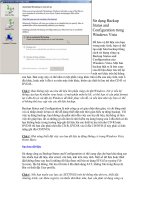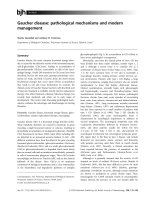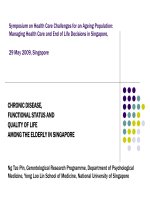Tài liệu Chronic Disease, Functional Status and Quality Of Life Among The Elderly In Singapore pdf
Bạn đang xem bản rút gọn của tài liệu. Xem và tải ngay bản đầy đủ của tài liệu tại đây (358.79 KB, 29 trang )
Symposium on Health Care Challenges for an Ageing Population:
Managing Health Care and End of Life Decisions in Singapore,
29 May 2009, Singapore
Ng Tze Pin, Gerontological Research Programme, Department of Psychological
Medicine, Yong Loo Lin School of Medicine, National University of Singapore
Aims:
Assess salient health and social needs of elderly Singaporeans
Identify vital areas that are likely to present the best avenues
and opportunities for success in achieving longer and healthier
life expectancy.
Methodology:
Data from the baseline survey of participants in the Singapore
Longitudinal Ageing Studies (SLAS)
Thesis:
The present trend of functional disability is increasing
It should be reversed by measures taken to improve quality of
geriatric care, assisted living and long-term care, designs for
housing, built environment and transportation, and promotion of
‘active ageing’.
Population ageing in Singapore is
rapid and unprecedented
Persons aged 65 +
8% in 2009
19% in 2030
Enormous health care and social
challenges of population ageing
have to be faced much sooner
rather than later
Percent Increase in Elderly Population: 2000 to 2030
Demographic transition is accompanied by epidemiological
transition
Acute and communicable diseases are replaced by cancer and
chronic degenerative and metabolic diseases
372
277
240
240
216
197
174
170
126
108
102
92
55
54
0 50 100 150 200 250 300 350 400
Japan
United Kingdom
New Zealand
United States
Australia
Canada
China
India
Thailand
South Korea
Indonesia
Philippines
Malaysia
Singapore
Changing affluent lifestyles
and habits
Increased chronic
diseases incidences
Improved healthcare
Increased chronic diseases
and functional disability
Reduce mortality and prolong
survival
Little impact on functional
wellbeing or quality of life
Escalate use and costs of
medical and social services
Increase burden of care for
family and caregivers
QUALITY OF CARE is now a critical factor that
determines whether the current cohort of
Singaporean seniors faces the prospect of
better functional wellbeing and quality of life in
their later years
Presently available data do not indicate a
benevolent trend of physical functional
wellbeing in the near to medium term
Regular monitoring of physical functional
status are needed
What can we do now to ensure that our current
policies and programmes are effective in achieving
longer and healthier life expectancy?
What are the vital areas of health and social
interventions that are likely to present the best
avenues and opportunities for success?
What are the present deficiencies and barriers that
can be identified and corrected?
Essential for optimal policy and programme planning and
provisions
Data are available from official routine health statistics and reports
(national health surveys, special surveys of the elderly)
Not comprehensive or relevant enough
Lack detailed information on relevant biological, psychosocial and
behavioural status for elderly subjective wellbeing e.g mental
health and quality of life (healthy ageing)
Multi-disciplinary collaboration of research aimed at understanding
the ageing and health transition of Singaporean older adults
Goal to help formulate strategies of disease prevention and health
promotion for healthy and long life expectancy
Wide range of research topics and issues relevant to public health,
primary care, and hospital and nursing home care
Population-based observational prospective cohort study of older
adults aged 55+ in South East Singapore
2,808 participants (78.5% response)
Baseline data on a wide range of demographic, biological, clinical,
psychosocial and behavioral characteristics
Extensive battery of structured health interviews, assessments and
blood tests.
Follow up assessment after 2 years and 4 years.
Cross-sectional data from the baseline interviews and examination are
used to describe the health and psychosocial status and service usage
of the elderly in this presentation
Sample
2808 seniors aged 55 to 98
Mean age 66
49% were aged 65 +
13% aged 75 +
63% women
1/2 at least a secondary education
82% Chinese
2/3 resident in larger and higher end housing units (at least 4
rooms HDB)
Note: relatively better socio-demographic profile of study
respondents
High proportion with chronic medical conditions
9 out of 10 seniors reported having at least one chronic health
condition
43% have at least three multiple conditions
Hypertension (56%)
blood lipid abnormalities (59%)
major eye disorders (33%)
arthritis and other musculoskeletal disorders (17%)
diabetes (19%)
coronary heart disease (6%)
stroke (4%)
13% significant depressive symptoms
11% psychiatric disorder diagnosis
24% cognitive impairment
6% dementia (65+ years)
3.5% reported history of treatment for mental illness
2% reported at least two falls in the past six months
Higher rates of chronic health conditions in older age groups
4.1% was hospitalized at least once in the year
2 in 3 seniors visited a doctor at least once in the year
1 in 3 reported that they did not make a single visit to a doctor (?)
The elderly make greatest demands on the healthcare system
Healthcare expenditure will inevitably increase from the present
3% or 4%
Depression and health services
use by Singaporean seniors
Increases physician visits and
hospitalization episodes
(Int
Psychogeriatrics, 2006; 11:1-16)
Increases hospital length of
stay and mortality in COPD
patients
(Arch Intern Med. 2007 Jan
8;167(1):60-7)
Associated with polypharmacy,
poor medication adherence
and lifestyle modification
behaviour
(Drugs Aging. 2008;25(9):795-
805).
0
5
10
15
20
25
Multiple (>5) drugs use Inappropriate drug use
Non-depressed
Depressed
%
P<0.001
P<0.001
4003002001000
Days from discharge
1.0
0.8
0.6
0.4
0.2
0.0
Proportion of Patients Survived
Non-depressed
Depressed
0.58
0.93
2.48
1
0.00
0.50
1.00
1.50
2.00
2.50
3.00
None Dementia
only
Depression
only
Depression
and
Dementia
Relative Risk of Hospitalization for chronic Illnesses
Requires broad and integrated perspective
Should consider:
primary care and hospital treatment of chronic
diseases
community-based programmes for mental health
and falls prevention
Physical functional disability
Increasing prevalence in recent decades
Contrast declining prevalence in West
J Am Ger Soc 2006; 54:21–29.
1985
1995
1997
2003
2005
Age
(Kua)
(MCYS)
(Yadav)
(SLAS)
(MCYS)
55+
4.1%
7.4%
7.8%
75+
14.4%
26.3%
% are for Dependency on Basic Activities of Daily Living (ADL)
Multivariate
OR
P<0.05
Age (vs 60-69)
70-79
4.4
80+
13.6
Female gender
2.9
Indian ethnicity
2.1
Living with others
5.7
Poor-Fair self-rated health
3.5
Self-reported chronic condition
Arthritis
2.2
Urinary problems
4.6
Stroke
6.9
Asthma/ COPD
7.6
Hip fracture
34.9
Kidney failure
24.2
Cognitive functioning
MMSE 24+
1.0
MMSE 19-23
4.7
MMSE ≤18
10.5
Hearing impairment
3.1
Visual impairment
2.5
Population
attributable risk
Arthritis
14.0%
Cognitive impairment
19.0%
Ng et al, J Am Ger Soc 2006; 54:21–29.
Arthritis and cognitive
impairment are the
leading modifiable
causes
Risk Factors and Correlates
Multiple measures targeted at
improving cognitive and
musculoskeletal function is
likely to make the strongest
impact in improving physical
functional wellbeing of the
elderly
0
10
20
30
40
50
60
Physical
functioning
Role
physical
Bodily
Pain
Vitality
Social
functioning
General
Health
Role
Emotional
Mental
Health
QOL (SF-12) scores
Lower for physical dimensions than mental dimensions
For both physical and mental dimensions, social role limitations
accounted mostly for reported poor quality of life
In the face of impaired physical and mental functioning, perceived
social handicap stands in the way of realizing quality of life
Success in improving physical and social functioning and quality of life
will be determined by measures taken to improve
• Access and quality of medical care
• Assisted living and long-term care
• Designs for housing, built environment and transportation,
• Promotion of ‘active ageing’
Greater attention should be given to improving the level of social
support and the physical environment to lessen the extent of social
handicap from the loss of function
Primary care, hospital and community levels
Direct and immediate impact on reducing physical
impairment from chronic diseases
Current medical care appears to have limited
effectiveness in producing desirable care outcomes in
the elderly
Avoidable Hospitalization Rates in Singapore
Ng et al, Journal of Epidemiology and Community Health, 2003; 57,1: 17-22.
Addresses the problem at its source
Effective programme of mass education to modify
harmful lifestyles and behaviour and early risk
detection
Need to be sustained over long term and overcome
challenges and difficulties in changing health
behaviour
Smoking rates are dramatically brought down
Modest improvements in levels of hypertension,
diabetes, hypercholesterolaemia, and physical activity.
Levels of obesity increased
Levels remain high and longer-term sustenance is not
beyond doubt
‘Active Ageing’ embodies the practical wisdom of this approach
Promotes the highest possible level of wellbeing in old age
Best long-term prospect for alleviating burden of care and high
costs of health spending in old age, better quality of life
“The process of optimizing opportunities for physical, social and
mental well-being throughout the life course in order to extend
healthy life expectancy.'' (Ministry of Health, Canada).
Officially promoted by the World Health Organization (2002) and
Committee on Ageing Issues Report, 2006.
Active ageing policies and programmes have begun to be
coordinated by Council for the Third Age.









